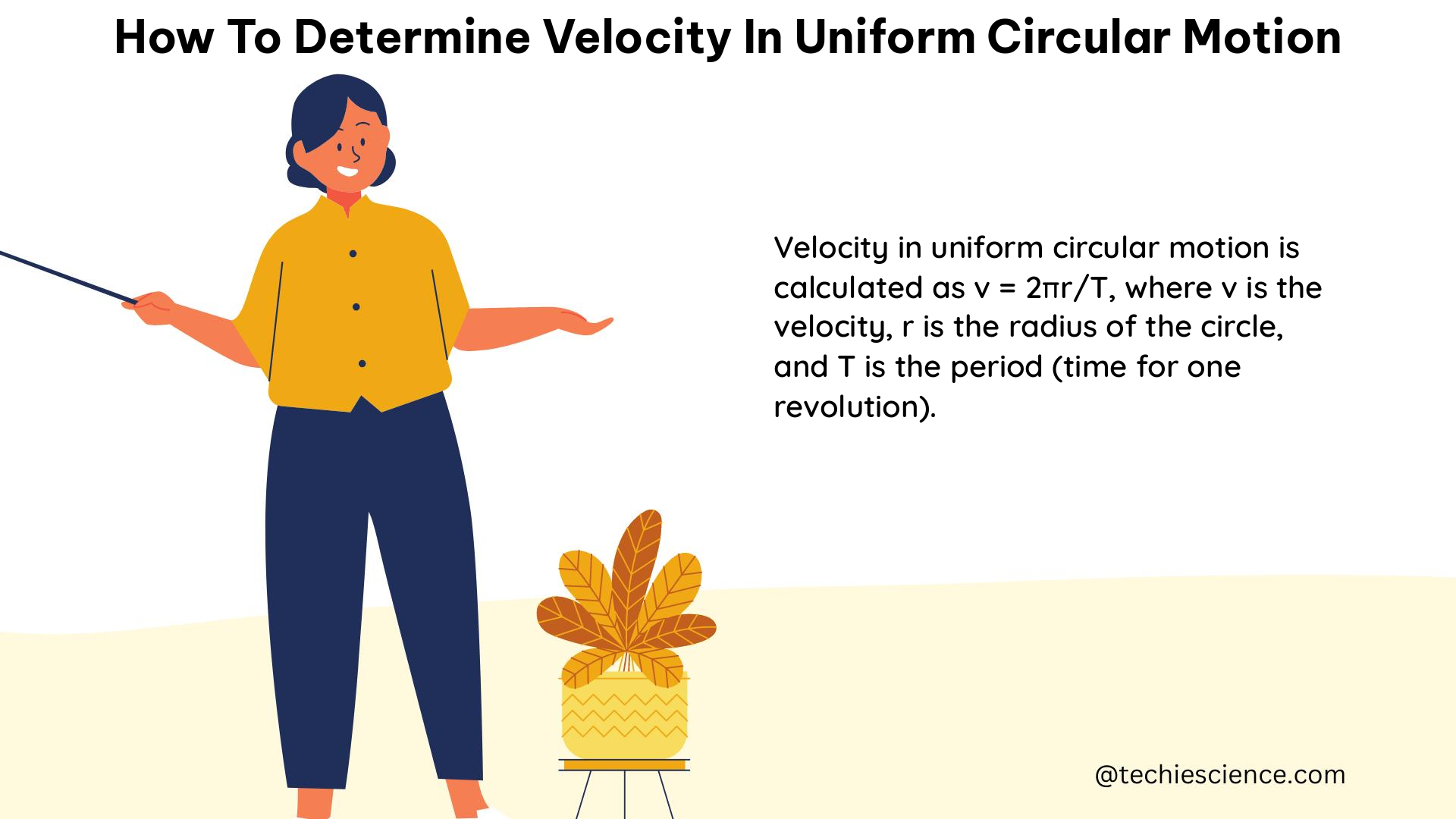Summary
Determining the velocity in uniform circular motion is a fundamental concept in physics. The circular velocity, denoted as vc, is directly proportional to the radius of the circular path and inversely proportional to the time taken by the object to complete one revolution. This article will provide a comprehensive guide on how to calculate the circular velocity using various formulas and examples, as well as how to determine the radius and time given the circular velocity.
Understanding Circular Velocity

In uniform circular motion, an object moves in a circular path at a constant speed. The circular velocity, vc, is the speed of the object as it travels around the circular path. The formula to calculate the circular velocity is:
vc = 2πr/T
Where:
– vc is the circular velocity (in m/s)
– r is the radius of the circular path (in m)
– T is the time taken to complete one revolution (in s)
The circular velocity is directly proportional to the radius of the circular path, meaning that as the radius increases, the circular velocity also increases. Conversely, the circular velocity is inversely proportional to the time taken to complete one revolution, meaning that as the time taken increases, the circular velocity decreases.
The unit of circular velocity is meters per second (m/s), and the dimensional formula is [M^0 L^1 T^-1].
Example Calculations
-
If the radius of the circular path is 3 meters and the time taken is 4 seconds, the circular velocity would be:
vc = 2πr/T = (2 × 3.14 × 3)/4 = 18.84/4 = 4.71 m/s -
If the radius is 5 meters and the time taken is 2 seconds, the circular velocity would be:
vc = 2πr/T = (2 × 3.14 × 5)/2 = 31.4/2 = 15.7 m/s -
If the radius is 4 meters and the time taken is 7 seconds, the circular velocity would be:
vc = 2πr/T = (2 × 3.14 × 4)/7 = 25.12/7 = 3.58 m/s
Calculating Circular Velocity Using Angular Velocity
Another way to determine the circular velocity is by using the angular velocity, ω, which is the rate of change of the angle of the object as it moves around the circular path. The formula to calculate the circular velocity using angular velocity is:
vc = ωr
Where:
– vc is the circular velocity (in m/s)
– ω is the angular velocity (in rad/s)
– r is the radius of the circular path (in m)
Example Calculations
-
If the angular velocity is 5 rad/s and the radius is 3 meters, the circular velocity would be:
vc = ωr = 5 × 3 = 15 m/s -
If the angular velocity is 8 rad/s and the radius is 4 meters, the circular velocity would be:
vc = ωr = 8 × 4 = 32 m/s
Determining the Radius Given Circular Velocity
If the circular velocity of an object undergoing circular motion is known, you can use the formula to determine the radius of the circular path:
r = vcT/2π
Where:
– r is the radius of the circular path (in m)
– vc is the circular velocity (in m/s)
– T is the time taken to complete one revolution (in s)
Example Calculations
-
If the circular velocity is 5 m/s and the time taken is 3 seconds, the radius would be:
r = vcT/2π = (5 × 3)/(2 × 3.14) = 15/6.28 = 2.38 m -
If the circular velocity is 8 m/s and the time taken is 2 seconds, the radius would be:
r = vcT/2π = (8 × 2)/(2 × 3.14) = 16/6.28 = 2.54 m
Determining the Time Given Circular Velocity
If the circular velocity of an object undergoing circular motion is known, you can use the formula to determine the time taken to complete one revolution:
T = 2πr/vc
Where:
– T is the time taken to complete one revolution (in s)
– r is the radius of the circular path (in m)
– vc is the circular velocity (in m/s)
Example Calculations
-
If the circular velocity is 7 m/s and the radius is 5 meters, the time would be:
T = 2πr/vc = (2 × 3.14 × 5)/7 = 31.4/7 = 4.48 s -
If the circular velocity is 12 m/s and the radius is 8 meters, the time would be:
T = 2πr/vc = (2 × 3.14 × 8)/12 = 50.24/12 = 4.18 s
Additional Considerations
- The circular velocity is a vector quantity, meaning it has both magnitude and direction. The direction of the circular velocity is always tangent to the circular path.
- In uniform circular motion, the acceleration of the object is directed towards the center of the circular path, and is called the centripetal acceleration.
- The relationship between the circular velocity, angular velocity, and radius is given by the equation:
vc = ωr. - The period of the circular motion,
T, is the time taken to complete one revolution, and is related to the angular velocity by the equation:T = 2π/ω. - Uniform circular motion is a fundamental concept in physics and has many applications, such as in the motion of planets, satellites, and rotating machinery.
Reference:
- Uniform Circular Motion – University of Minnesota
- Uniform Circular Motion Lab – University of Michigan
- Circular Velocity Formula – GeeksforGeeks

The lambdageeks.com Core SME Team is a group of experienced subject matter experts from diverse scientific and technical fields including Physics, Chemistry, Technology,Electronics & Electrical Engineering, Automotive, Mechanical Engineering. Our team collaborates to create high-quality, well-researched articles on a wide range of science and technology topics for the lambdageeks.com website.
All Our Senior SME are having more than 7 Years of experience in the respective fields . They are either Working Industry Professionals or assocaited With different Universities. Refer Our Authors Page to get to know About our Core SMEs.